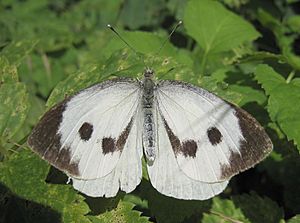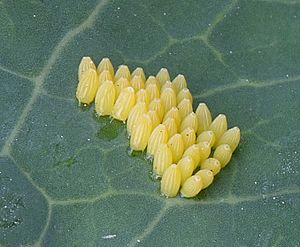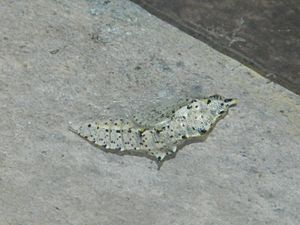Large white facts for kids
Quick facts for kids Large white |
|
|---|---|
 |
|
| Male | |
 |
|
| Female | |
| Scientific classification | |
| Genus: |
Pieris (butterfly)
|
| Species: |
brassicae
|
| Synonyms | |
|
|
The Large White butterfly, also known as the cabbage butterfly or cabbage white, is a common butterfly found in many parts of the world. Its scientific name is Pieris brassicae. This butterfly belongs to the family Pieridae, which includes many white and yellow butterflies. It is a close relative of the Small White butterfly, Pieris rapae.
Large White butterflies are well-known because their caterpillars often eat plants like cabbage and broccoli. This can sometimes make them a pest for farmers.
Contents
Where Large White Butterflies Live
The Large White butterfly is very common across Europe, North Africa, and Asia, reaching as far as the Himalayas. You can often find them in places where there are farms, open fields, and parks.
They are strong flyers and often travel long distances. Butterflies from mainland Europe frequently fly to Britain, adding to the local population.
The Story in New Zealand
In 2010, the Large White butterfly was discovered in Nelson, New Zealand. It was called the "great white butterfly" there. Because it could harm crops, it was seen as an unwanted pest.
The Department of Conservation even offered a reward in October 2013. People could get $10 for each butterfly they caught. This effort, along with many searches and the release of tiny predatory wasps, helped a lot. By December 2014, New Zealand officially declared that the Large White butterfly had been completely removed from the country.
Life Cycle of the Large White Butterfly
Like all butterflies, the Large White goes through several stages: egg, larva (caterpillar), pupa (chrysalis), and adult butterfly.
Eggs
The eggs of the Large White butterfly are pale yellow when first laid. Within a day, they turn a darker yellow. Just before they hatch, the eggs become black, and you can sometimes see the tiny caterpillar inside.
Larvae (Caterpillars)
Large White caterpillars grow by shedding their skin four times. Each stage between these molts is called an "instar."
- First Instar: When they first hatch, the caterpillars are light yellow. They have brown heads and look very hairy.
- Later Instars: As they grow, they develop black hairs on small bumps. They become more active and eat a lot, causing damage to plants. They also become more yellow with black dots.
- Fifth Instar: In their final stage, they are cylindrical and robust. They are yellow with bright colors on their body and a grey and black head. At this stage, they need a lot of good food to grow into a butterfly.

Pupae (Chrysalises)
After the caterpillar stage, the larva forms a chrysalis. This is a resting stage where the caterpillar transforms into a butterfly.
Imagines (Adult Butterflies)
Adult Large White butterflies have white wings with black tips on their front wings. Female butterflies also have two black spots on each front wing. The underside of their wings is a pale greenish color. This helps them blend in with their surroundings when they are resting. The black markings are usually darker in butterflies that hatch in the summer. The wingspan of a Large White butterfly is typically about 5 to 6.5 centimeters (2 to 2.5 inches).
Male Butterflies
The top side of the male's wings is creamy white. The front wings have black scales near the base and along the edge. The tips and outer edges of the front wings are black. Sometimes, there's a small black spot on the front wing. The hindwings are mostly white with some black scales near the base. They might have a black spot near the tip. The underside of the wings is white, with the tips of the front wings and the hindwings being light brownish-yellow.
Female Butterflies
Female butterflies look similar to males, but they have more black scales on their wings. The black areas on the tips and edges of their front wings are wider. They also have a large, clear black spot on their front wings. The black spot on the hindwing is also bigger and stands out more. The underside of the female's wings is similar to the male's, but the tips of the front wings and the entire hindwing are a light yellowish color.
Large White Butterfly Habitat
Large White butterflies prefer open areas like fields, farms, and vegetable gardens. This is because these places have plenty of their favorite food plants. They often rest on walls, fences, tree trunks, and on their food plants. They especially like areas with wild and cultivated plants like cabbage, oil-seed rape, and Brussels sprouts.
Large White Butterfly Behavior
Migration
Large White butterflies are found across most of Eurasia. Their numbers can change with the seasons due to migration. Butterflies from southern areas often fly north during the summer. Large Whites start flying in early spring and continue migrating until the cold weather of autumn arrives. This means they usually have two to three flights during their breeding season.
These butterflies can migrate over 800 kilometers (about 500 miles). It's hard to track their exact paths because individual butterflies might not fly the whole distance. Instead, some butterflies might start their journey where others ended theirs.
Hibernation
Large White butterflies in northern areas usually do not survive the winter. However, they have been seen to hibernate successfully in warmer, southern regions.
Territorial Behavior
Male Large White butterflies do not show much territorial behavior. This might be why there isn't a big difference in appearance between male and female Large White butterflies.
Ecology of the Large White Butterfly
Diet and Food Selection
Large White butterflies are picky eaters, especially when they are caterpillars. Studies show that their food choices depend on what they have eaten before. This means they learn what foods they prefer.
Plants that contain mustard-oil glucosides are very important for these butterflies. When caterpillars eat these plants, the mustard oils make them taste bad to predators like birds. Even though the caterpillars are brightly colored, this color is a warning sign to predators that they are not tasty. This helps protect them from being eaten.
The caterpillars of the Large White butterfly eat cabbages, radishes, and the undersides of leaves. Adult butterflies drink nectar from flowers.
Predators
Large White butterflies are eaten by many different animals and even some plants. Their main predators are birds. However, they can also be preyed upon by wasps, true bugs, beetles, flies, spiders, some mammals, reptiles, and even insect-eating plants. They can be eaten at all stages of their life: as eggs, caterpillars, and adult butterflies.
Warning Colors (Aposematism)
Large White butterflies give off an unpleasant smell that helps keep predators away. They also use warning colors, which is called aposematism. This means they have bright colors that tell predators they are dangerous or taste bad. This warning coloration is seen in the caterpillar, pupa, and adult stages. The toxic mustard oil glycosides they get from their food plants are stored in their bodies, making them unappetizing.
Large White Butterflies and People
Role as Pests
Large White butterflies can cause a lot of damage to crops, especially plants in the Brassica family. These include cabbage, mustard, Brussels sprouts, cauliflower, kohlrabi, rape, swede, and turnip. In some areas, they can destroy 100% of a crop. Because they migrate so well, adult butterflies can quickly infest new areas that were previously safe.
Since many of their host plants are grown for food, damage by these butterflies can greatly reduce the value of crops. The caterpillars can also bore into the heads of cabbage and cauliflower, causing more harm. If there are too many caterpillars, they can even eat all the leaves off a plant.
In places like Great Britain, Large White butterflies are less of a pest now due to natural controls and pest management. However, they are still a problem in other European countries, China, India, Nepal, and Russia. In India and Turkey, they are estimated to cause over 40% of crop loss each year for certain vegetables.
Subspecies
Here are some of the different types (subspecies) of the Large White butterfly:
- Pieris brassicae azorensis Rebel, 1917
- Pieris brassicae brassicae (Linnaeus, 1758)
- Pieris brassicae catoleuca Röber, 1896
- Pieris brassicae cyniphia (Turati, 1924)
- Pieris brassicae cypria Verity, 1908
- Pieris brassicae italorum Stauder, 1921
- Pieris brassicae nepalensis Gray, 1846
- Pieris brassicae ottonis Röber, 1907
- Pieris brassicae subtaeniata (Turati, 1929)
- Pieris brassicae wollastoni (Butler, 1886) †
Images for kids
See also
 In Spanish: Mariposa de la col para niños
In Spanish: Mariposa de la col para niños






